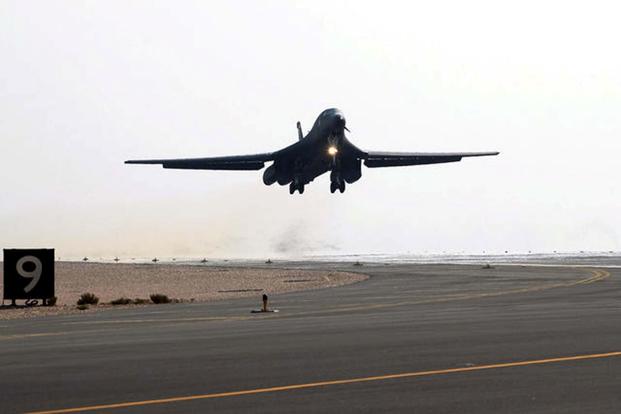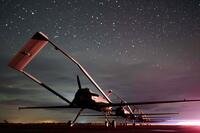Bradley Bowman is senior director of the Center on Military and Political Power at the Foundation for Defense of Democracies (FDD), where Maj. Lauren Harrison is a visiting military analyst and Ryan Brobst is a research analyst. FDD is a nonpartisan research institute focused on national security and foreign policy. Follow Bradley on Twitter @Brad_L_Bowman.
The opinions expressed in this op-ed are those of the authors and do not necessarily reflect the views of Military.com. If you would like to submit your own commentary, please send your article to opinions@military.com for consideration.
Israeli and Saudi fighter jets participated in the same patrol mission (albeit at different times) on Oct. 30, accompanying a U.S. Air Force B-1B Lancer bomber circumnavigating the Arabian Peninsula and attempting to send a deterrence message to Tehran.
Riyadh's willingness to join a military mission involving Israel is the latest indication that the actions of the Islamic Republic of Iran are incentivizing some Arab capitals to tiptoe toward overt security cooperation with Israel.
The B-1B is a bomber capable of carrying a larger payload of conventional weapons than any other aircraft in the U.S. Air Force inventory. The aircraft's flight path makes clear the mission's purpose: assuring America's allies and partners in the Middle East while sending a deterrence message to Tehran.
The bomber flew in or near the airspace of Egypt, Israel, Jordan, Kuwait, Saudi Arabia, Bahrain and the United Arab Emirates, while skirting along almost the entire southern maritime border of Iran. It flew over the strategic Gulf of Aden, Bab el-Mandeb Strait, Red Sea, Suez Canal, Arabian Gulf, Strait of Hormuz, and Gulf of Oman. These waterways mark some of the world's busiest shipping routes and have been plagued by numerous Iranian-sponsored attacks on oil tankers and nearby refineries.
Admittedly, U.S. bomber flights in that region are not uncommon. The U.S. Air Force headquarters responsible for the Middle East said the bomber flight was the fifth so-called "presence patrol" in 2021, following a series of flights in 2020. Both the Trump and Biden administrations have used the bomber flights to reassure Washington's friends and warn Tehran.
While the bomber's patrol through the Middle East was not particularly newsworthy, the participants were. During the five-hour flight, the American bomber was escorted (at different times) by fighter aircraft from Israel and three Arab countries. That includes F-16s from Bahrain and Egypt and F-15s from Israel and Saudi Arabia.
The Saudi contribution is the most interesting part. That's because Saudi Arabia -- unlike Bahrain, Egypt, Jordan and the United Arab Emirates -- has not normalized relations with Israel. Saturday's flight represented only the second time that Riyadh has participated in a U.S. bomber patrol mission that included Israeli aircraft. In March, two U.S. Air Force B-52H Stratofortress bombers flew a similar patrol in the Middle East and were accompanied at different points by Israeli, Saudi and Qatari aircraft.
The flight follows last month's Israeli-hosted Blue Flag 2021 exercise, which featured a landmark visit to Israel by the chief of the UAE Air Force.
The main reason for this growing Israeli-Arab security cooperation is a shared concern regarding Tehran's aggression toward its neighbors and region-wide efforts to sow instability and terrorism.
The bomber flights may be a necessary measure against Tehran, but they clearly are insufficient. To be certain, the flights demonstrate American strike capability and remind decision-makers in Tehran that a large-scale conventional military conflict with the United States likely would not end well for Iran. The flights also reiterate that the United States has the means to devastate Tehran's nuclear program. At the same time, the bomber flights clearly have not persuaded Iran to stop exporting terrorism, building its missile and drone arsenal, or inching toward a nuclear weapons capability.
The Oct. 30 flight comes as the Biden administration is pushing Iran to return to the negotiating table to revive the now-defunct Iran nuclear agreement. The country's top nuclear negotiator announced Wednesday that Iran agreed to resume negotiations on Nov. 29. An Iranian desire to achieve sanctions relief, not the B-1B's flight, likely explains that announcement.
While the involvement of Saudi and Israeli fighters in the same mission is significant, that development does not necessarily mean normalization between Saudi Arabia and Israel is imminent. In its press release regarding the patrol mission, Riyadh failed to mention Israel, actually referring to the multilateral mission as a "bilateral exercise" with the U.S. Air Force. On Oct. 31, the Saudi foreign minister, Prince Faisal Bin Farhan al-Saud, said a Palestinian state is a precondition for Riyadh to normalize relations with Israel.
Yet this position may reflect transient politics more than long-term policy. Indeed, an Israeli commercial jet landed in Riyadh in late October, reportedly marking the first time an Israeli public flight has landed in the Kingdom. That first occurred a day after a Saudi jet landed at Israel's Ben Gurion Airport.
Regardless, to defend common security interests in the face of growing Iranian aggression, Saudi Arabia and Israel would be wise at least to continue tiptoeing toward increased security cooperation.
-- The views expressed in this commentary are those of the authors and do not necessarily represent the views of the Defense Department or the Air Force.















